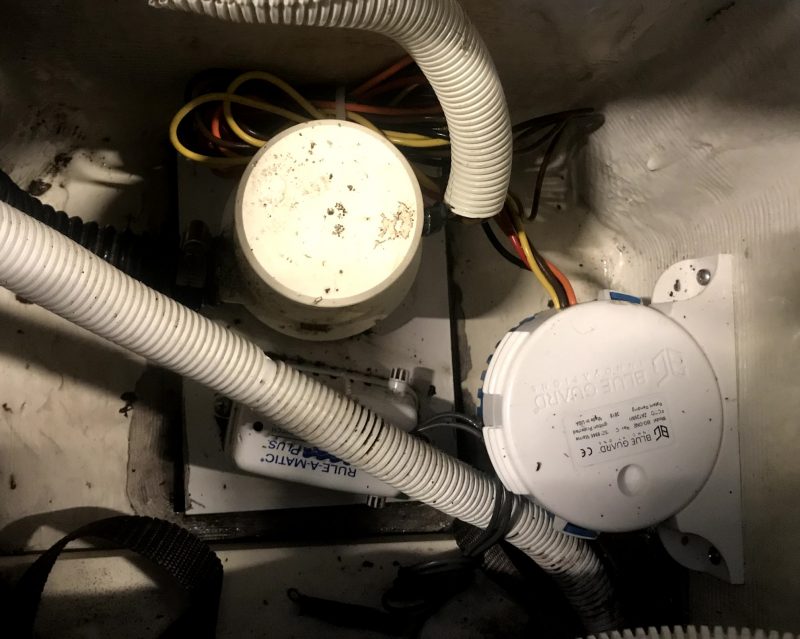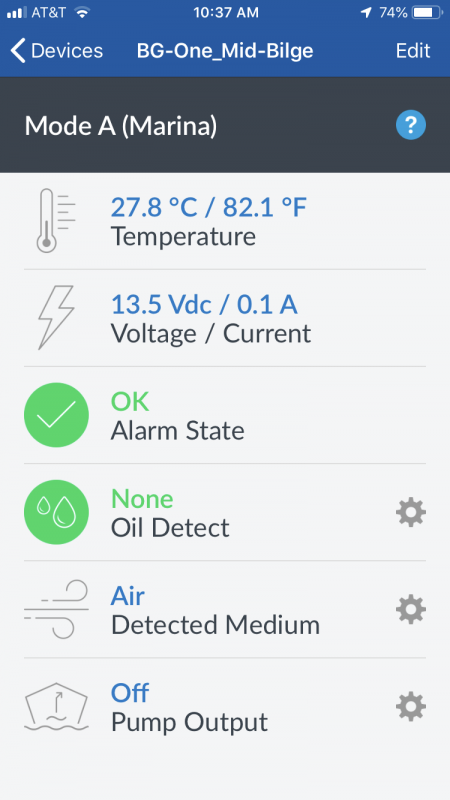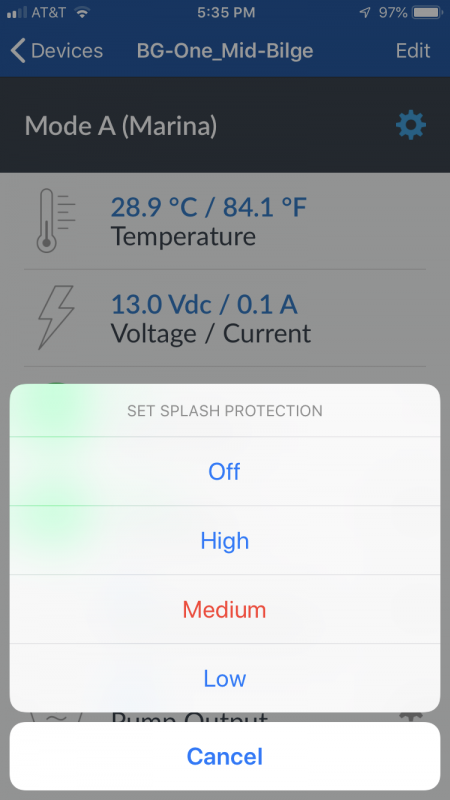Testing Blue Guard’s BG-One oil detecting bilge pump switch
In the last six months Blue Guard Innovations’ BG-One Smart Bilge Pump Switch with Oil and Fuel Detector racked up new product awards, winning an IBEX Innovations Award, a Sail magazine Pittman Award, and a DAME design award Special Mention. So it’s great to have one now installed on Have Another Day, and so far I’m liking both its performance and the amount of information it provides.
The $220 Blue Guard BG-One can prevent your boat from pumping out oil and fuel that might be floating on top of water in your bilge, and it’s also highly configurable, as I detailed in this October entry and also as demonstrated in the video above.
Installing the switch was pretty straightforward once I figured out the existing wiring and how best to connect to it. Unlike the typical mechanical float switch it replaced — only wired inline with one positive leg of the boat’s bilge pump cable — the BG-One needs constant 12v power. Moreover, if your boat also has a positive leg for a manual pump switch, the BG-One wants to monitor and supervise that as well. The wires seen above are black for ground, orange for always live, red for manual bilge pump control, brown for positive to the pump and yellow for connecting an external alarm.
In other words, all three wires in my feed cable now go to the BG-One and the ground had to be split to the pump. It would have been helpful if Blue Guard had included a sample diagram for replacing a simple float switch. Also, you may have noticed the BG-One is installed higher than the mechanical float switch it replaced (which is still mounted in case I need to switch back for any reason); this is because Blue Guard calls for mounting the switch two inches above the discharge of the pump.
- The BGI Config device discovery screen
- The BG-Ones status
Once installed it was easy to fire up the iOS version of the BGI Config app (also available for Android) and see the switch’s capabilities, which reminded me of Ben E’s recent post about the goodness of Bluetooth device configuration. The app immediately displays a list of the Blue Guard Innovations products found — only one for me right now, but on the screen above left I’ve already given it a custom name. And clicking on BG-One_Mid-Bilge shows the informative screen at the right. Besides bilge temperature, voltage at the switch and current consumed, the Detected Medium of “Air” means that neither oil nor water are sensed.
- I submerged the BG-One in a tray of water for testing purposes
- When the sensor detects its in water it starts the bilge pump
- Once the sensor detects its no longer in water it shows the contacts are wet, but turns off the pump
Before installing the BG-One, I tested it in a half-filled pan. As soon as it hit the water, it turned on the pump while the app (middle image above) indicated the water detection along with active pump status. Once the water went down — or in my case the switch was removed from the pan — the pump turned off but the BG-One was able to tell that its sensors were still wet, which could be a useful indicator that there’s water sloshing around in a bilge.
- Set the mode of the switch
- Adjust the splash sensitivity
- Adjust the amount of time the pump runs to clear the discharge line
You can use the app to show the status of a BG-One at any time — or use the optional $225 BG-CP control panel — but if you want to make configuration changes you need to connect to the switch within one minute of a power cycle. (I found this a little cumbersome as the breakers for the bilge pumps on Have Another Day are protected to prevent accidental tripping, so I had to grab a screwdriver each time to trip the breaker.)
Once in config mode you can choose the switch Mode — which range between normal pump-everything anti-sinking safety (High Seas) to pump-nothing environment safety (Sanctuary) — and also adjust splash protection sensitivity or set the pump run time needed to clear the discharge line (the pump runs continuously as long as water is detected).
So far, I’d say that the BG-One provides an incredible amount of information and intelligence compared to what’s provided by a standard bilge pump float switch. Moreover, Blue Guard just announced a BG-Link system that promises off-boat monitoring with wireless integration to the BG-One and other sensors. I plan to install and test the BG-Link soon, so there’s more to come.























Well, I’m impressed! Paying $219 for a really smart bilge pump switch doesn’t seem crazy to me because I once almost pumped many gallons of diesel into a gorgeous section of the ICW. Lord knows what would have cost me in shame, hassle, and dollars.
Also, I did locate a somewhat obscure BG-One wiring diagram and it suggests that the yellow oil detect alarm wire can be rigged to a simple trouble light if I don’t bother with the BG control panel:
https://www.bluebgi.com/applications/switch/#bilge-pump-switch-oil-fuel
Would be nice if you mentioned the instructions from BGI:
Maintenance After Oil or Fuel is Detected
After oil is detected in the bilge, the leak repaired and oil discarded it is time to clean the BG-One or BG-Oil’s sensors. Wipe down the sensors with a soft, clean cloth to remove any oil residue. If any further cleaning is required, use rubbing alcohol or soapy solution to gently clean the sensor followed by wiping with a soft, clean cloth
Hi All.
I have just purchased a BG-SW Solid-State Bilge Pump Switch and BG-CP
Control Panel for my boat as it will tick all the boxes for what I need.
But here’s a question which I can not find the answer to – can I add a BG-Link
IoT Marine Gateway system to it?
I think it would be fantastic to have the versatility of the system whilst being able to monitor it remotely when I am not on the boat using all the feature of the link system.
Any ideas?
The BG-Link system is a pretty separate system from their bilge pump switches, but the two integrate nicely. The BG-Link’s bilge pump sensors have inputs for bilge pump activation, oil detection, and high-water. So, depending on how you’re using the bilge pump switches you will definitely be able to wire it up and get good information from the BG-SW into the BG-Link.
-Ben S.